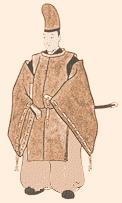|
In 794, the Emperor moved the capital from Nara
to Heian-kyo (Kyoto).
The city's design was based on the square pattern of the Chinese
city, Chang-an.
The Fujiwara family controlled the Japanese
Emperors and dominated the imperial court from the 9th to the 12th
century. In 858 Fujiwara Yoshifusa (804-72)
acquired the office of sessho (regent), which
then became hereditary in his family. His nephew Mototsune
(836-91) became the first kampaku (chancellor).
 The two most powerful clans of the time were the Taira
(Heike) and Minamoto
(Genji). The Taira finally defeated the
Minamoto and ousted the Fujiwara to take control of the imperial
court. This was the Heiji Rebellion,
of 1160. There were though, Minamoto survivors of the battle and
they would challenge the Taira again.
The two most powerful clans of the time were the Taira
(Heike) and Minamoto
(Genji). The Taira finally defeated the
Minamoto and ousted the Fujiwara to take control of the imperial
court. This was the Heiji Rebellion,
of 1160. There were though, Minamoto survivors of the battle and
they would challenge the Taira again.
Gempei War: 1180-1185
During this war many battles between the Taira and Minamoto were
fought. Of note is the battle of Uji
River, 1180. The Minamoto defended the river crossing, supported
by a band of warrior monks, but were defeated by the Taira. Minamoto
Yorimasa ,committed seppuku at the nearby Byodo-in
temple. Later, however the strength of the Taira was significantly
weakened by the death of the Taira leader Kiyomori
in 1181.
The next significant battle was Ichi-No-Tani,
1184. Minamoto Yoshitsune, general and
brother of Yoritomo, their clan leader,
successfully attacked a seashore fort of the Taira by leading their
samurai down a steep cliff face to penetrate the defences. Yoshitsune,
chased the fleeing Taira to Yashima on
Shikoku Island and defeated their base there.
The last battle of the war, Dan-No-Ura,
1185 was on the sea at Shimonoseki. Yoshitsune, won and finally
destroyed the Taira. The child Emperor Antoku
was drowned by his grandmother in order that he not be taken by
the Minamoto.
Now that Yoshitsune had removed all opposition the way was clear
for his brother
Minamoto-no-Yoritomo, to establish a new government.
|


